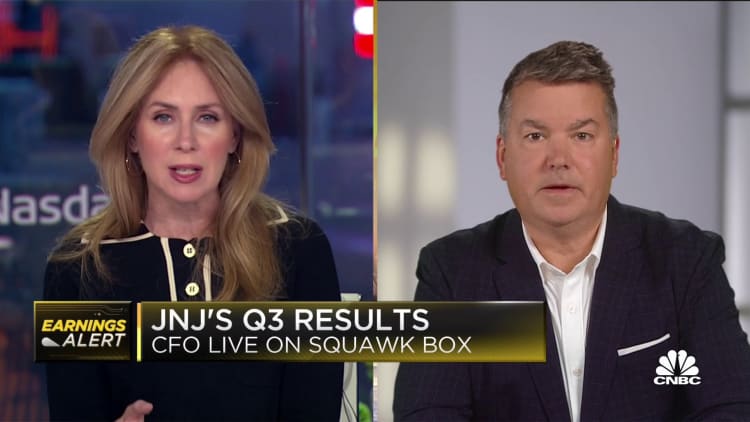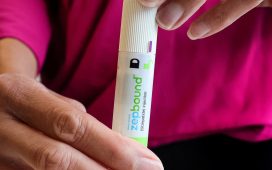
Johnson & Johnson on Tuesday reported adjusted earnings and revenue that topped Wall Street’s expectations, and lifted its full-year guidance as sales in the company’s pharmaceutical and medical devices businesses surged.
It marks J&J’s first quarterly results since it completed the separation from its consumer health spinoff Kenvue in August, the company’s biggest shake-up in its 137-year history.
Upon that separation in August, J&J also lowered its full-year sales and profit guidance.
The drugmaker raised that revised outlook on Tuesday: J&J expects 2023 sales of $83.6 billion to $84 billion, compared with previous guidance of $83.2 billion to $84 billion in August. J&J also expects adjusted earnings per share of $10.07 to $10.13, up from a previous forecast of $10.00 to $10.10.
J&J also said it recorded a one-time, non-cash gain of $21 billion as part of the split of Kenvue.
Here’s what J&J reported for the third quarter compared with what Wall Street was expecting, based on a survey of analysts by LSEG, formerly known as Refinitiv:
- Earnings per share: $2.66 adjusted vs. $2.52 expected
- Revenue: $21.35 billion vs. $21.04 billion expected
J&J’s stock closed nearly 1% on Tuesday. Shares of J&J have dropped more than 12% for the year, putting the company’s market value at roughly $376 billion.
The company, whose financial results are considered a bellwether for the broader health sector, said its sales during the quarter grew 6.8% over the same period last year.
| Jim Cramer’s Investing Club shares what investors should listen for in a company’s earnings call
The pharmaceutical giant reported net income of $4.31 billion, or $1.69 per share. That was flat compared with net income of $4.31 billion, or $1.62 per share, for the same period a year ago.
Excluding certain items, adjusted earnings per share were $2.66 for the period.
An entry sign to the Johnson & Johnson campus shows their logo in Irvine, California on August 28, 2019.
Mark Ralston | AFP | Getty Images
J&J reported $13.89 billion in pharmaceutical sales, which grew more than 5% year over year. Excluding sales of its unpopular Covid vaccine, the pharmaceutical division raked in $13.85 billion.
Wall Street was expecting sales of $13.34 billion for the entire business segment, according to StreetAccount. The business, also known as “Innovative Medicine,” is focused on developing drugs across different disease areas.
The company said the growth was driven by sales of Darzalex, a biologic for the treatment of multiple myeloma, along with Erleada, a prostate cancer treatment, and other oncology treatments.
J&J’s blockbuster drug Stelara, which is used to treat a number of immune-mediated inflammatory diseases, also contributed to that growth. J&J will lose patent protection on Stelara later this year.
The company said growth was partially offset by a decline in sales of its prostate cancer drug Zytiga and blood cancer drug Imbruvica, which is co-marketed by AbbVie and will be subject to the first round of Medicare drug price negotiations.
J&J’s Covid vaccine also weighed on pharmaceutical sales growth. This quarter was the second without any U.S. sales from J&J’s Covid vaccine, which brought in $41 million in international revenue.
“Our success was never dependent on the Covid vaccine,” J&J CFO Joseph Wolk said Tuesday on CNBC’s “Squawk Box.”
Meanwhile, sales for the company’s medical devices business rose to nearly $7.46 billion, up 10% from the third quarter of 2022. That came in under Wall Street’s expectations of $7.58 billion, according to StreetAccount.
J&J said its acquisition of Abiomed, a cardiovascular medical technology company, in December fueled the year-over-year rise.
J&J said growth came from electrophysiological products, which evaluate the heart’s electrical system and help doctors understand the cause of abnormal heart rhythms.
Wound closure products and devices for orthopedic trauma, or serious injuries of the skeletal or muscular system, contributed, along with contact lenses.
The third-quarter results come amid investor anxiety over the thousands of lawsuits claiming that J&J’s talc-based products were contaminated with the carcinogenic asbestos, which caused ovarian cancer and several deaths.
Those products, including J&J’s namesake baby powder, now fall under Kenvue. But J&J will assume all talc-related liabilities that arise in the U.S. and Canada.
In 2021, J&J offloaded its talc liabilities into a new subsidiary, LTL Management, and immediately filed for Chapter 11 bankruptcy protection. But a federal bankruptcy judge in July rejected J&J’s second attempt to resolve those lawsuits in bankruptcy.
J&J previously said LTL Management intends to appeal the decision.
The quarterly results also come as J&J begins price talks with the federal Medicare program over its drug Xarelto, which is used to prevent blood clotting to reduce the risk of stroke.
President Joe Biden‘s Inflation Reduction Act, which passed in 2022, empowered Medicare to negotiate drug prices for the first time in the program’s six-decade history. J&J signed an agreement to participate in the price talks last month, even after it sued the Biden administration to halt the process in July.
Wolk said during an earnings call Tuesday that J&J submitted all requested information in compliance with the federal government’s negotiation process.
But Wolk also reiterated the company’s opposition to the negotiations, “We continue to believe the IRA’s price-setting provisions are damaging to innovation and will prevent the delivery of transformative therapies and cures to patients as we await adjudication of legal proceedings initiated by us and others.”














